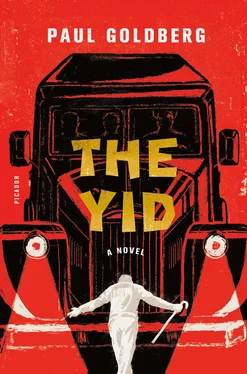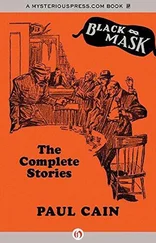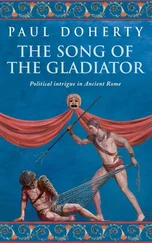There will be no trial. Lewis’s new motherland has liberated itself from the notion that convicts are entitled to an appearance of an investigation and an appearance of due process of law. There are show trials; there are secret trials; there are deportations of entire ethnic populations, such as Chechens, Crimean Tatars, and young Lithuanian men. Now, an entirely different form of extra-legal repression is starting to emerge. This is mob rule. Unburdened by civilization, it is tribal.
No, Lewis will not play Levinson and Kogan’s hypocritical game of protecting the young lady from the madness of their time.
“Perhaps we should monitor systematically what kind of railroad cars are going toward Moscow and what kind of railroad cars are leaving,” he suggests.
Kima looks up with surprise.
Lewis continues. “We shouldn’t worry about all railroad cars.”
Kogan nods, and most people would have stopped at this point, but Lewis thinks and speaks methodically and therefore needs to complete his idea.
“We shouldn’t worry about tank cars or open platforms. In other words, we should examine the composition of trains going in and out.”
Kogan shakes his head. This is frustrating, but nothing can be done.
LEWIS: If trains bound for Moscow are predominantly pulling cattle cars, and if trains going out are predominantly composed of tank cars and platforms, we may be in for some trouble.
LEVINSON: The spare lines, too.
LEWIS: We could check them out. If there are freight trains standing off the main tracks, it’s a bad sign. And if they are made up exclusively of cattle cars, our situation is even worse.
KOGAN: This doesn’t rule out a fluke. I’d have a greater degree of certainty if we could consider the train depots.
LEWIS: That’s right. If we see nothing but cattle cars, and no tank cars, and no platforms, we are … What’s the Yiddish word …
KOGAN: What’s the English word?
LEWIS: Fucked.
MOISEY SEMYONOVICH: Farflokhtn ?
LEWIS: Sounds right.
KIMA: I don’t know Yiddish. What is it in Russian?
KOGAN: Nam khudo.
The goat is protecting her from profane language, too, Lewis concludes.
KIMA: I’ll go to the depot.
KOGAN: I’ll go with you.
LEWIS: As will I.
LEVINSON: No, Kogan, let her take Lewis. He’s younger and faster, and he’s been cooped up too long.
KIMA: Tonight.
LEVINSON: Tomorrow. Tonight, we visit a friend.
* * *
Late in the evening of February 25, the members of the conspiracy walk out into the blizzard. Their destination is the house of Meyer Kuznets, a seventy-nine-year-old follower of a religious leader based in Brooklyn, New York.
According to a Malakhovka rumor carefully circulated only among the most reliable people, seven years earlier, together with other religious Jews, all of Kuznets’s family vanished from Leningrad. The younger Kuznetses took a westward-bound train and now resided beside their leader.
Is it possible that at that time the Iron Curtain had a hole large enough for a train to pass through? Did every Hasid on that train have false papers? How were these documents made? By whom? Did the Hasidim have protection from above? Was it Kaganovich? Molotov? Beria?
In 1947, secret police grilled Kuznets, but the old man spoke in riddles, and in response to threats, wove tales of inspiration. It is said that during a daylong session, he tricked a captain of state security into acknowledging native command of Yiddish.
* * *
On their two-kilometer journey alongside the railroad tracks, Lewis, Levinsion, Moisey Semyonovich, and Kogan encounter a train pulling cattle cars toward Moscow. Lewis sees no platforms and no tank cars.
“They are having a big agricultural fair, Kogan,” says Levinson. “Prize-winning goats from Kazakhstan! Sheep from Abkhazia! Bulls from Ukraine!”
Kogan, Lewis, and Moisey Semyonovich walk in silence.
“Kogan, listen, I said goats,” Levinson tries again. “You thought your family was killed by Hitler? Not true! They are being brought to Moscow, to the agricultural fair! My family was mostly people. They are dead. Kogan, you are lucky to be a goat! Did you hear me?”
“Don’t respond to his provocations,” advises Moisey Semyonovich.
Kogan doesn’t require advice.
He is busy with calculations.
What is the Jewish population of the USSR? About 2.2 million. It’s possible to deport them. Hitler killed about three times this number. Of course, he did this over seven years, building an infrastructure for transportation and liquidation.
How many people can you squeeze into one cattle car? About sixty, if you don’t care how many of them are still breathing upon arrival. A train pulling fifty cattle cars can move three thousand people. Let’s say you are trying to move four hundred thousand people from Moscow alone. (This is Kogan’s best estimate.)
You need about 130 of these trains, if you pack them tightly, no luggage. The trains have to stand ready, because the deportation will have to be carried out quickly, while the pogroms continue to spread across the country.
You round up the majority of obvious Jews immediately and mop up the secret Jews later. You get them to the stations, have them waiting under guard.
Assuming absolute efficiency, you’d need about 730 such trains to transport the entire Jewish population to Port Nakhodka, the railhead of the Trans-Siberian Railroad. Kogan’s rough calculations don’t include cars for the guards, who would keep the deported Jews in the trains while making at least some effort to hold back the marauding mobs.
Of course, things will get muddled in the provinces. You will be running trains from one regional center to another, wasting coal, causing tie-ups. And, inevitably, some trains will be captured by the mobs, their passengers slaughtered.
How do you supply this number of deportees with water? Food? What about sanitation? Are the transit prisons large enough to accommodate them along the way? Will the system overload? Will it collapse? What will they do with the dying and the dead? Throw the corpses into the taiga, to fatten up the wolves? And what about those who survive?
And then comes the biggest obstacle of all: the rails take prisoners only as far as Port Nakhodka. If Kolyma is the destination, the rest of the journey will have to be done by barges, which carry a thousand or so prisoners at a time. Have new barges been built? If not, the concentration of deportees will become so heavy that selections for liquidation could be required.
Excessive calculation was Hitler’s principal miscalculation. This operation will be carried out the Soviet way: improvised, cheap, vicious.
KOGAN: Levinson, you do know who will conduct the roundups?
LEVINSON: Red Army.
KOGAN: Our Red Army? We fought for this?
LEVINSON: What did we fight for?
KOGAN: Can you remember?
MOISEY SEMYONOVICH: I fought for the cultural autonomy of the Jewish people, and I would again.
LEVINSON: Lewis, he is a Martian.
MOISEY SEMYONOVICH: Another failed provocation, Solomon.
KOGAN: Speaking only for myself, I don’t know what I fought for. It must have been the spirit of the times. The wind of history.
LEVINSON: The wind of history?
KOGAN: Yes, Levinson, divine wind!
LEVINSON: You want the spirit of the times? You want divine wind?
After carrying out this time-honored setup, Kogan places a gloved hand over his nostrils. “You are farting into the blizzard, komandir. ”
Shooting sideways glances at a slowly moving freight train, Lewis surrenders to deep, dull anguish. He will die here, in this dark, cold, impoverished land. In Omaha, he learned to associate death with the smell of burning houses, marauding mobs, humiliation. This will be different. There will be no hangman’s noose, no posthumous castration. Only a hail of bullets, a burst of pain, then irretrievable silence … surrender.
Читать дальше












